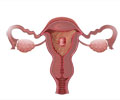Highlights
- Fetal growth restriction (FGR) can now be detected accurately with three-dimensional (3D) magnetic resonance imaging (MRI).
- The technology characterizes the shape, //volume, morphometry and texture of placenta during pregnancy.
- It helps identify factors that impair the growth of the fetus and provides an estimate of the birth weight.
The research team characterized the shape, volume, morphometry and texture of placentas during pregnancy and, using a novel framework, predicted with high accuracy which pregnancies would be complicated by fetal growth restriction (FGR).
"When the placenta fails to carry out its essential duties, both the health of the mother and fetus can suffer and, in extreme cases, the fetus can die. Because there are few non-invasive tools that reliably assess the health of the placenta during pregnancy, unfortunately, placental disease may not be discovered until too late--after impaired fetal growth already has occurred," says Catherine Limperopoulos, Ph.D., co-director of research in the Division of Neonatology.
Fetal Growth Restriction (FGR)
Two groups of pregnant volunteers between 18 and 39 weeks of gestation were recruited. Among the subjects,46 had healthy pregnancies and 34 FGR.FGR was defined as the estimated fetal weight that fell below the 10th percentile for gestational age.
The estimated the birth weight in both healthy and high-risk fetuses was assessed throughout the second half of gestation.
The technique has the potential to address a sizable clinical gap since there is a lack in methods that are both sufficiently sensitive and specific to reliably detect FGR in utero.
The method should further be done in a larger group of patients to expand knowledge about underlying placenta mechanisms responsible for disturbed fetal growth.
Also, it can help identify more completely characterize other potential predictors of fetal/placental development in high-risk pregnancies, such as genetics, physiology and nutrition.
Reference
- Sonia Dahdouh et al., In vivo placental MRI shape and textural features predict fetal growth restriction and postnatal outcome, Journal of Magnetic Resonance Imaging (2017) http://dx.doi.org/10.1002/jmri.25806.
Source-Medindia













